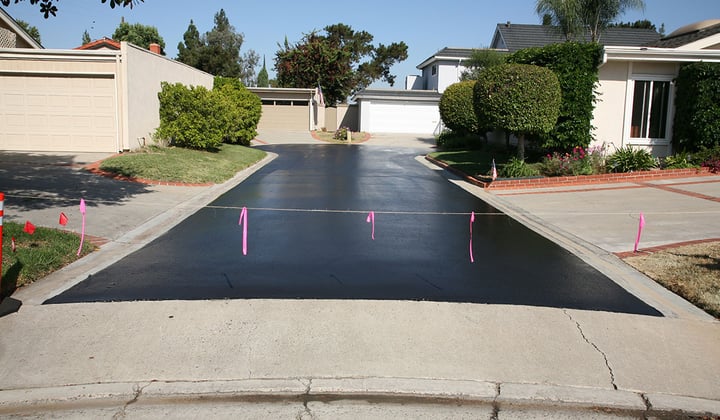Swift Solutions for Asphalt Patch Repair: Ideal Sealing Methods
Swift Solutions for Asphalt Patch Repair: Ideal Sealing Methods
Blog Article
Cold Mix Asphalt Vs. Hot Mix Asphalt: Which Is Right for You?

Structure Distinctions
Cold mix asphalt is created by emulsifying the asphalt binder with water and an emulsifying representative prior to blending it with accumulation. The warm mix asphalt manufacturing procedure entails heating the aggregate and asphalt binder individually before combining them at the asphalt plant.
In addition, cool mix asphalt often tends to be much less thick and extra flexible than warm mix asphalt. This adaptability makes it far better fit for areas with higher degrees of activity, such as driveways or roadways with rush hour. In comparison, warm mix asphalt is understood for its high toughness and resistance to rutting and cracking, making it a favored option for highways and high-traffic roads where durability is vital.
Installment Refine Variations
The process of installing cold mix and warm mix asphalt displays significant variations in their needs and procedures. Cold mix asphalt, being a more flexible product, can be used directly from the bag or container onto the gap or damaged location. It requires very little preparation job, such as cleaning up the location and compacting the cool blend with hand tools. This makes it a convenient option for short-term and quick fixes. On the other hand, warm mix asphalt requires a more intricate installment process. It involves heating the combination to high temperature levels before laying it down on a correctly prepared base. The preparation includes compacting the base, applying a tack coat, and making use of heavy machinery like pavers and compactors for a smooth and sturdy coating. Because of the heating demands, hot mix asphalt installments are generally carried out by experts with customized tools, guaranteeing an extra permanent and structurally audio outcome.
Toughness and Durability Elements
When considering asphalt alternatives, longevity and durability are important factors to assess for enduring pavement performance. Hot mix asphalt (HMA) is known for its phenomenal sturdiness and longevity.
In regards to durability, HMA normally outmatches CMA due to its remarkable toughness and resistance residential properties. HMA pavements have a longer life span, calling for much less frequent fixings and upkeep, which can convert to cost savings in the future. Additionally, HMA sidewalks are more conveniently adjustable to satisfy certain job requirements, even more enhancing their toughness.
Cost Considerations
Considering the monetary ramifications is an essential element when examining the choice in between warm mix asphalt (HMA) and cold mix asphalt (CMA) for sidewalk projects. While the initial expense of hot mix asphalt is generally more than that of cool mix asphalt, HMA frequently provides a much more cost-efficient solution over time due to its superior longevity and longevity. HMA is understood for its ability to withstand rush hour lots and harsh climate condition, lowering the need for constant repair work and upkeep. On the other hand, cool mix asphalt is more budget-friendly upfront yet may need more frequent patching and resurfacing, resulting in higher maintenance prices over time.
In enhancement to product costs, it's essential to think about the expenditures linked with installation and upkeep when comparing HMA and CMA. Inevitably, the decision in between HMA and CMA must take into account not just the first cost however also the long-lasting economic implications to figure out the most cost-effective alternative for the specific pavement task.
Environmental Impact Comparison
Contrast of the ecological influences in between hot mix asphalt (HMA) and cold mix asphalt (CMA) reveals distinct differences in sustainability practices. HMA manufacturing calls for high temperature levels, leading to look what i found increased power intake and greenhouse gas exhausts.
Additionally, the use of CMA often entails recycling existing asphalt pavement, promoting resource preservation and reducing the amount of waste sent to land fills. By choosing for CMA over HMA, road building and construction projects can contribute favorably to environmental preservation efforts.
Conclusion
Finally, the choice between cool mix asphalt (CMA) and hot mix asphalt (HMA) depends upon numerous aspects such as composition, setup procedure, sturdiness, long life, expense, and ecological impact. asphalt patch repair. While CMA offers a economical and fast solution for minor repair services, HMA ensures exceptional longevity and longevity for click site heavy traffic locations. Take into consideration these factors thoroughly to figure out which kind of asphalt is the appropriate selection for your paving needs

Considering the financial effects is a vital element when evaluating the option in between warm mix asphalt (HMA) and cool mix asphalt (CMA) for pavement projects. While the preliminary cost of warm mix asphalt is generally greater than that of cool mix asphalt, HMA commonly provides a much more cost-efficient solution in the lengthy run due to its premium toughness and longevity. angle parking.Contrast of the ecological impacts in between warm mix asphalt (HMA) and cool mix asphalt (CMA) over at this website reveals distinct differences in sustainability techniques.In conclusion, the choice between chilly mix asphalt (CMA) and hot mix asphalt (HMA) depends on numerous elements such as structure, setup process, longevity, long life, expense, and ecological influence
Report this page